Gypsum Board Market
Gypsum Board Market Size and Share Forecast Outlook 2025 to 2035
Gypsum board market is projected to grow from USD 27.0 billion in 2025 to USD 36.5 billion by 2035, at a CAGR of 3.1%. Standard will dominate with a 62.0% market share, while residential will lead the application segment with a 46.0% share.
Gypsum Board Market Forecast and Outlook 2025 to 2035
The global gypsum board market is projected to grow from USD 27,000.0 million in 2025 to approximately USD 36,500.0 million by 2035, recording an absolute increase of USD 9,500.0 million over the forecast period. This translates into a total growth of 35.2%, with the market forecast to expand at a compound annual growth rate (CAGR) of 3.1% between 2025 and 2035.
The overall market size is expected to grow by 1.4X during the same period, supported by increasing demand for efficient building materials, rising adoption of modern construction technologies, and growing focus on fire-resistant and moisture-resistant construction solutions across the global building and construction sectors.
Quick Stats for Gypsum Board Market
- Gypsum Board Market Value (2025): USD 27,000.0 million
- Gypsum Board Market Forecast Value (2035): USD 36,500.0 million
- Gypsum Board Market Forecast CAGR: 3.1%
- Leading Type in Gypsum Board Market: Standard (62.0%)
- Key Growth Regions in Gypsum Board Market: Asia Pacific, North America, and Europe
- Key Players in Gypsum Board Market: Saint-Gobain, Knauf, USG, Etex, Georgia-Pacific, National Gypsum, Lafarge, Boral, Siniat, Yoshino Gypsum, CertainTeed, Gyptec, Tiger Gypsum, PABC

The market dynamics driving gypsum board adoption are fundamentally shaped by urbanization pressures, construction industry modernization, and the building sector's transformation toward energy-efficient and multi-functional building materials.
Rapid urban population growth has intensified construction demand across major metropolitan regions, compelling architects and builders to implement more sophisticated building material strategies. Climate change considerations and building safety regulations in many jurisdictions increasingly incentivize efficient construction materials through energy codes, fire safety standards, and moisture control mandates that make advanced gypsum board systems economically attractive investments.
Technological advancement in manufacturing processes, material composition, and installation techniques has dramatically enhanced the capabilities and accessibility of gypsum board systems. Modern boards leverage advanced gypsum formulations, fiber additives, and surface treatments to provide enhanced fire resistance, moisture control, and dimensional stability from standard installation to specialized applications.
The integration of production automation, quality control systems, and performance testing enables these materials to meet precise construction specifications based on actual structural requirements rather than basic installations, resulting in significant performance improvements and enhanced building outcomes.
The construction sector's increasing adoption of advanced building technologies has created substantial demand for integrated building material solutions that complement existing construction management systems. Gypsum boards now interface seamlessly with modern building systems, enabling comprehensive performance characteristics and analysis that supports broader construction decision-making processes.
This integration capability has proven particularly valuable for large-scale commercial construction operations where coordinated management of multiple building zones and construction types requires sophisticated material specifications and performance capabilities.
Economic considerations increasingly favor gypsum board adoption as construction costs continue rising and labor availability affects building operations. Advanced systems reduce installation requirements for building construction while improving structural performance, creating compelling return-on-investment scenarios for construction producers.
The ability to prevent moisture damage, provide fire resistance, and optimize installation timing based on construction schedules generates measurable cost savings that often justify initial material investments within relatively short payback periods.
Between 2025 and 2030, the gypsum board market is projected to expand from USD 27,000.0 million to USD 31,100.0 million, resulting in a value increase of USD 4,100.0 million, which represents 43.2% of the total forecast growth for the decade.
This phase of development will be shaped by rising demand for fire-resistant building systems, increasing applications in residential construction and commercial building technologies, and growing penetration in emerging construction automation markets.
Building material manufacturers are expanding their production capabilities to address the growing demand for customized gypsum boards in various construction segments and building management programs.
Gypsum Board Market Key Takeaways
| Metric | Value |
|---|---|
| Estimated Value in (2025E) | USD 27,000.0 million |
| Forecast Value in (2035F) | USD 36,500.0 million |
| Forecast CAGR (2025 to 2035) | 3.1% |
From 2030 to 2035, the market is forecast to grow from USD 31,100.0 million to USD 36,500.0 million, adding another USD 5,400.0 million, which constitutes 56.8% of the overall ten-year expansion. This period is expected to be characterized by the expansion of advanced construction infrastructure, the integration of cutting-edge building technologies, and the development of customized gypsum board systems for specific construction applications.
The growing adoption of modern construction standards and building automation will drive demand for ultra-high efficiency gypsum boards with enhanced performance specifications and consistent manufacturing characteristics.
Between 2020 and 2025, the gypsum board market experienced steady expansion, driven by increasing recognition of advanced building materials' importance in construction operations and growing acceptance of specialized gypsum systems in complex building markets.
The market developed as builders recognized the need for high efficiency building materials to address construction requirements and improve overall operational productivity. Research and development activities have begun to emphasize the importance of advanced manufacturing technologies in achieving better efficiency and performance in construction processes.
Why is the Gypsum Board Market Growing?
Market expansion is being supported by the increasing demand for fire-resistant construction infrastructure and the corresponding need for high efficiency building control systems in construction applications across global building and construction management operations.
Modern construction operators are increasingly focused on advanced building technologies that can improve operational efficiency, reduce material consumption, and enhance system performance while meeting stringent safety requirements.
The proven efficacy of gypsum boards in various construction applications makes them an essential component of comprehensive building strategies and construction modernization programs.
The growing emphasis on modern construction and advanced building optimization is driving demand for ultra-efficient building systems that meet stringent performance specifications and operational requirements for specialized applications.
Construction operators' preference for reliable, high-performance building materials that can ensure consistent structural delivery is creating opportunities for innovative manufacturing technologies and customized construction solutions.
The rising influence of modern construction protocols and building automation standards is also contributing to increased adoption of premium-grade gypsum boards across different construction applications and building systems requiring advanced material technology.
Opportunity Pathways - Gypsum Board Market
The gypsum board market represents a specialized growth opportunity, expanding from USD 27,000.0 million in 2025 to USD 36,500.0 million by 2035 at a 3.1% CAGR. As builders prioritize operational efficiency, fire resistance, and system performance in complex construction processes, gypsum boards have evolved from a basic building material to an essential component enabling structural management, performance optimization, and multi-stage construction production across building operations and specialized construction applications.
The convergence of construction expansion, increasing automation adoption, specialized building infrastructure growth, and safety requirements creates momentum in demand. High-efficiency formulations offering superior performance characteristics, cost-effective standard systems balancing performance with economics, and specialized moisture-resistant variants for demanding applications will capture market premiums, while geographic expansion into high-growth Asian construction markets and emerging market penetration will drive volume leadership. Construction emphasis on efficiency and performance provides structural support.
- Pathway A - Standard Type Dominance: Leading with 62.0% market share, standard applications drive primary demand through complex construction workflows requiring comprehensive building systems for modern construction. Advanced formulations enabling improved operational efficiency, reduced material consumption, and enhanced performance characteristics command premium pricing from builders requiring stringent performance specifications and quality compliance. Expected revenue pool: USD 16,740.0-22,630.0 million.
- Pathway B - Residential Application Leadership: Dominating with 46.0% market share through an optimal balance of performance and cost requirements, residential applications serve most building operations while meeting construction requirements. This application addresses both performance standards and operational considerations, making it the preferred choice for residential and building operations seeking reliable construction materials. Opportunity: USD 12,420.0-16,790.0 million.
- Pathway C - Asian Market Acceleration: India (4.0% CAGR) and China (3.5% CAGR) lead global growth through construction infrastructure expansion, modern building development, and domestic gypsum board demand. Strategic partnerships with local builders, construction compliance expertise, and supply chain localization enable the expansion of building technology in major construction hubs. Geographic expansion upside: USD 5,400.0-7,300.0 million.
- Pathway D - Sheets Form Premium Segment: Sheet forms serve specialized operations requiring exceptional performance specifications for critical construction processes. Sheet formulations supporting complex building requirements, modern construction applications, and performance-sensitive processes command significant premiums from advanced construction organizations and specialized building facilities. Revenue potential: USD 21,600.0-29,200.0 million.
- Pathway E - Advanced Manufacturing & Quality Systems: Companies investing in sophisticated building technologies, automated production systems, and intelligent quality processes gain competitive advantages through consistent system performance and operational efficiency. Advanced capabilities enabling customized specifications and rapid deployment capture premium construction partnerships. Technology premium: USD 2,700.0-3,650.0 million.
- Pathway F - Supply Chain Optimization & Reliability: Specialized distribution networks, strategic inventory management, and reliable supply chain systems create competitive differentiation in construction markets requiring consistent gypsum board availability. Companies offering guaranteed supply security, technical support, and compliance documentation gain preferred supplier status with efficiency-focused builders. Supply chain value: USD 1,620.0-2,190.0 million.
- Pathway G - Emerging Applications & Market Development: Beyond traditional construction installations, gypsum boards in industrial applications, specialized building processes, and novel construction systems represent growth opportunities. Companies developing new applications, supporting R&D initiatives, and expanding into adjacent construction markets capture incremental demand while diversifying revenue streams. Emerging opportunity: USD 1,080.0-1,460.0 million.
Segmental Analysis
The market is segmented by type, application, form, and region. By type, the market is divided into standard, moisture/fire-resistant, and specialty. Based on application, the market is categorized into residential, commercial, and industrial. By form, the market is divided into sheets and panels/boards. Regionally, the market is divided into Asia Pacific, North America, Europe, Latin America, Middle East & Africa.
By Type, Standard Segment Accounts for 62.0% Market Share
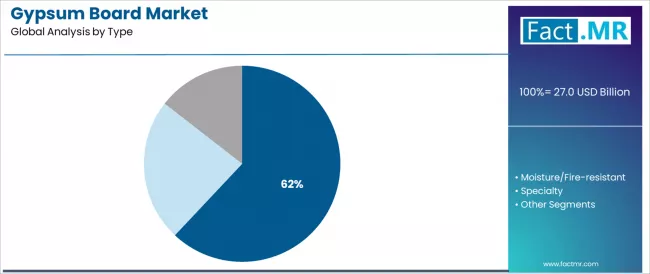
The standard segment is projected to hold 62.0% of the gypsum board market in 2025, reinforcing its position as the dominant type. Construction operators favor standard gypsum boards for their optimal balance of performance, reliability, and cost-effectiveness across a wide range of building applications, particularly in structural management and general construction processes.
This segment serves as the foundation for most construction protocols, representing the most widely accepted and commercially viable gypsum board technology. Ongoing quality standards and extensive operational testing continue to strengthen confidence in standard formulations. With increasing emphasis on performance-cost optimization in construction management, standard gypsum boards remain central to operational efficiency and comprehensive building strategies.
By Application, Residential Segment Accounts for 46.0% Market Share
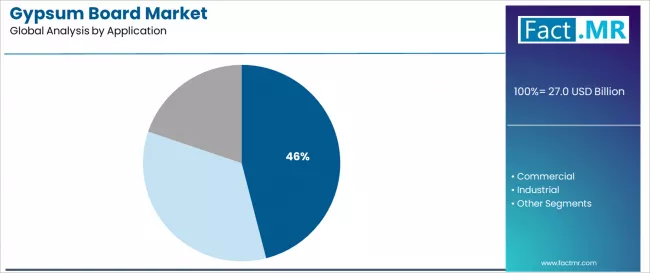
The residential segment is projected to account for 46.0% of gypsum board demand in 2025, underscoring its role as the primary application driving market adoption. Residential construction often involves complex building operations, specialized structural requirements, and multi-stage construction systems, where gypsum boards provide superior structural management and compliance.
Growth in this segment is supported by the rising complexity of construction projects and the adoption of evidence-based building guidelines that recommend specific gypsum boards for enhanced efficiency. As construction requirements become more stringent, gypsum boards will continue to play a pivotal role in residential building strategies, ensuring both performance and operational reliability.
By Form, Sheets Segment Accounts for 80.0% Market Share
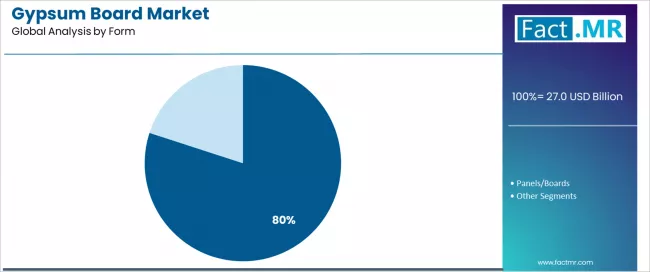
The sheets segment is projected to represent 80.0% of gypsum board demand in 2025, highlighting its critical role as the primary form driving market expansion. Sheet gypsum boards are preferred for their ability to meet complex construction demands, including specialized installation, multi-level building systems, and structural management needs.
Sheet-focused gypsum boards provide enhanced operational compliance and support efficient construction processes, reinforcing their position as the backbone of gypsum board applications across diverse construction projects. Their widespread adoption is underpinned by reliability, ease of installation, and compatibility with modern construction standards.
What are the Drivers, Restraints, and Key Trends of the Gypsum Board Market?
The gypsum board market is advancing steadily due to increasing recognition of advanced building technologies' importance and growing demand for high-efficiency construction systems across the building and construction sectors.
However, the market faces challenges, including complex installation processes, potential for performance variations during operation and maintenance, and concerns about supply chain consistency for specialized building equipment. Innovation in building technologies and customized construction protocols continues to influence product development and market expansion patterns.
Expansion of Advanced Construction Facilities and Building Technologies
The growing adoption of advanced construction facilities is enabling the development of more sophisticated gypsum board production and performance control systems that can meet stringent operational requirements.
Specialized construction facilities offer comprehensive building services, including advanced installation and monitoring processes that are particularly important for achieving high-efficiency requirements in structural applications.
Advanced construction infrastructure provides access to premium services that can optimize building performance and reduce material consumption while maintaining cost-effectiveness for large-scale construction operations.
Integration of Modern Building Systems and Construction Management Systems
Modern construction organizations are incorporating digital technologies such as real-time performance monitoring, automated installation systems, and building integration to enhance gypsum board deployment and distribution processes.
These technologies improve system performance, enable continuous operational monitoring, and provide better coordination between builders and construction operators throughout the building cycle.
Advanced digital platforms also enable customized performance specifications and early identification of potential system deviations or supply disruptions, supporting reliable construction production.
Analysis of the Gypsum Board Market by Key Country
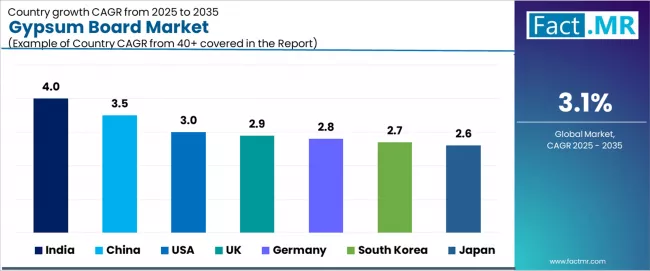
| Country | CAGR (2025-2035) |
|---|---|
| India | 4.0% |
| China | 3.5% |
| USA | 3.0% |
| Germany | 2.8% |
| South Korea | 2.7% |
| UK | 2.9% |
| Japan | 2.6% |
The global gypsum board market is experiencing varied growth across regions, with India leading at a CAGR of 4.0% through 2035. Growth is driven by the expansion of construction infrastructure, increasing building capacity, and rising domestic demand for high efficiency building control systems. China follows with a CAGR of 3.5%, supported by ongoing construction expansion, growing adoption of advanced building technologies, and enhanced building capacity.
The USA records a CAGR of 3.0%, underpinned by development in construction infrastructure and modernization of the building industry. Germany demonstrates a CAGR of 2.8%, driven by advanced construction technology adoption, while the UK records a CAGR of 2.9%, emphasizing systematic building approaches and infrastructure expansion. In Asia, South Korea shows a CAGR of 2.7%, and Japan registers a CAGR of 2.6%, both reflecting increasing focus on infrastructure development and methodical construction practices.
India Demonstrates Growing Market Potential with Construction Infrastructure Development
The gypsum board market in India is projected to grow at a CAGR of 4.0% through 2035, driven by rapid construction expansion and increasing recognition of high efficiency building systems as essential components for complex building projects. Expanding construction infrastructure and enhanced availability of specialized building materials are creating significant opportunities for gypsum board adoption across residential, commercial, and export-oriented construction facilities.
Major international and domestic building companies are establishing comprehensive material and distribution networks to serve India’s growing population of builders and construction facilities requiring high-performance systems for structural management and operational efficiency. Government initiatives supporting infrastructure modernization, urban development, and residential expansion are further driving demand for gypsum boards. Rising builder focus on high-value construction technologies positions gypsum boards as a critical element in the country’s construction transformation.
China Demonstrates Exceptional Market Potential with Construction Growth
China’s gypsum board market is expanding at a CAGR of 3.5%, supported by ongoing construction growth, rising awareness of advanced building systems, and the development of a robust construction technology ecosystem. Both domestic and international construction providers are establishing extensive distribution channels to meet increasing demand for high efficiency building materials.
The country’s favorable policies, expanding infrastructure, and cost-competitive construction environment are stimulating investments in specialized building technologies, including gypsum boards. Emphasis on reducing import dependency and improving supply chain reliability drives domestic sourcing of high-quality materials. Major construction hubs such as Beijing, Shanghai, and Guangzhou are witnessing increased adoption of advanced gypsum boards, particularly in residential and commercial applications where high-performance materials are essential.
USA Maintains Technology Leadership

The US gypsum board market is expected to grow at a CAGR of 3.0% through 2035, reflecting advanced construction infrastructure deployment and sophisticated integration of gypsum boards into building information systems. Builders prioritize system reliability, compliance with construction standards, and operational efficiency, driving demand for premium gypsum board solutions with performance validation and advanced features.
Gypsum boards are increasingly integrated into smart building platforms across major construction centers, ensuring optimized construction accuracy and workflow efficiency. The US market benefits from a mature construction ecosystem, ongoing investment in advanced building technologies, and a focus on long-term operational performance and compliance.
Germany Emphasizes Advanced Construction Technology
Germany’s gypsum board market is projected to grow at a CAGR of 2.8%, characterized by high-quality construction standards and precision integration of building systems. Builders prioritize advanced features such as material performance algorithms, system validation, and compatibility with automated construction platforms.
Locally manufactured gypsum boards that comply with German engineering standards are preferred, ensuring reliability, long-term performance, and adherence to strict operational requirements in specialized construction applications.
UK Emphasizes Construction Innovation
The UK market is projected to expand at a CAGR of 2.9%, driven by technology-integrated construction practices and sophisticated building infrastructure. Domestic manufacturing and strategic partnerships with European suppliers ensure consistent material availability post-Brexit.
The construction industry’s focus on energy efficiency, urban regeneration, and high-performance residential and commercial projects is driving demand for specialized gypsum boards, including moisture- and fire-resistant variants.
South Korea Emphasizes Advanced Manufacturing
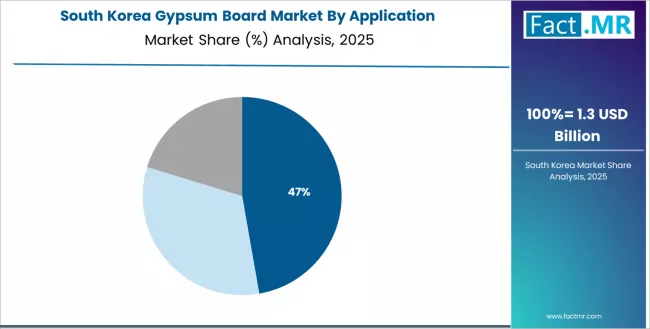
South Korea’s gypsum board market is expected to grow at a CAGR of 2.7%, underpinned by advanced construction infrastructure and high adoption of automated building technologies. Demand is driven by large-scale residential and commercial projects, smart city initiatives, and earthquake-resistant construction standards.
Local manufacturers and integrators are increasingly partnering with global providers to offer advanced gypsum board solutions that integrate with automated construction systems, supporting modern architectural designs and operational efficiency.
Japan Emphasizes Precision and Integration Excellence
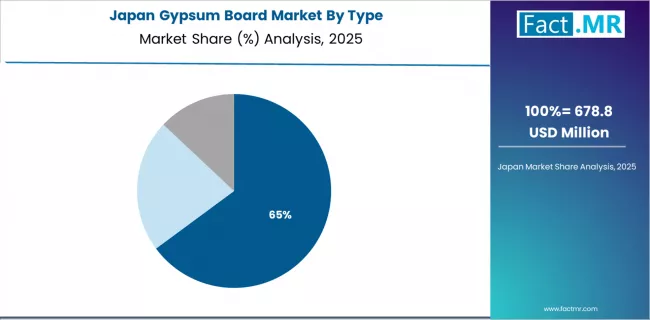
Japan’s gypsum board market is projected to grow at a CAGR of 2.6%, distinguished by the country’s focus on high-quality, precision-integrated construction systems. Standard gypsum boards dominate with 66.0%, followed by moisture/fire-resistant (28.0%) and specialty boards (6.0%), reflecting a strong preference for reliable, performance-driven construction solutions.
The mature construction market emphasizes durability, seismic resistance, and quality assurance, creating sustained demand for premium gypsum boards in urban centers such as Tokyo, Osaka, and Nagoya. Advanced manufacturing and rigorous quality control processes ensure consistent performance across diverse building applications.
Europe Market Split by Country
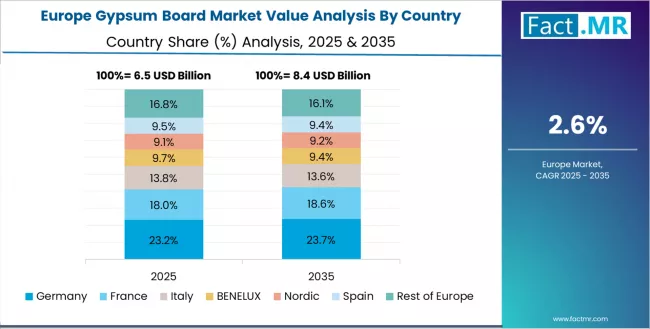
The gypsum board market in Europe demonstrates strong regional variation, reflecting differences in construction infrastructure and adoption of advanced building systems. Germany leads the market with a projected value of USD 5,600.0 million in 2025, supported by advanced construction capabilities, precision building standards, and a strong presence of established construction operators across major building regions.
Builders in Germany prioritize locally manufactured gypsum boards that comply with engineering standards, ensuring reliability, long-term performance, and seamless integration with existing construction platforms.
The United Kingdom follows with a market value of USD 4,150.0 million in 2025, driven by technology-integrated gypsum boards, expanding construction networks, and advanced material protocols. Domestic manufacturing capabilities and strategic partnerships with European suppliers ensure consistent material availability post-Brexit, while energy efficiency and building performance requirements support growing demand for moisture- and fire-resistant gypsum board variants.
France accounts for USD 3,300.0 million in 2025, supported by ongoing construction infrastructure expansion and increasing adoption of high efficiency building systems. Builders are focused on integrating modern gypsum boards into residential and commercial projects to enhance structural management, operational compliance, and long-term building performance.
Italy commands a market value of USD 2,650.0 million in 2025, while Spain represents USD 2,150.0 million, reflecting steady growth driven by urban development, residential construction expansion, and the adoption of reliable building materials that align with regional construction standards.
The Rest of Europe, including Nordic countries, Eastern Europe, and smaller Western European markets, holds USD 4,150.0 million in 2025. Growth in this segment is supported by the modernization of construction practices, adoption of advanced gypsum boards, and expanding building infrastructure across emerging markets. Diverse regional requirements, combined with investments in high-performance construction materials, are creating significant opportunities for gypsum board manufacturers across multiple European countries.
Competitive Landscape of the Gypsum Board Market
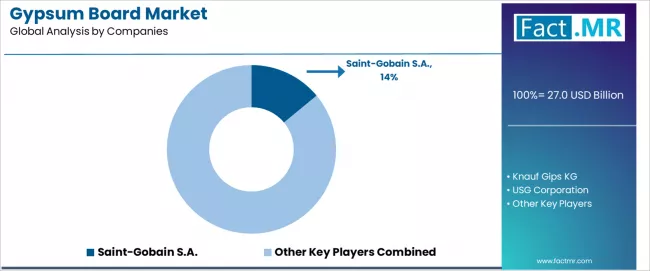
The gypsum board market is characterized by competition among established building material companies, specialty construction companies, and construction technology suppliers focused on delivering high-efficiency, consistent, and reliable building material systems. Companies are investing in material technology advancement, performance enhancement, strategic partnerships, and customer technical support to deliver effective, efficient, and reliable building solutions that meet stringent construction and building requirements. Performance optimization, quality validation protocols, and supply chain strategies are central to strengthening product portfolios and market presence.
Saint-Gobain leads the market with a 14.0% market share, offering comprehensive high-efficiency gypsum boards with a focus on performance consistency and material reliability for construction applications. Knauf provides specialized material systems with emphasis on building applications and comprehensive technical support services. USG focuses on advanced building technologies and customized construction solutions for material systems serving global markets. Etex delivers established building systems with strong performance material systems and customer service capabilities.
Georgia-Pacific operates with a focus on bringing innovative building technologies to specialized construction applications and emerging markets. National Gypsum provides comprehensive material system portfolios, including advanced building services, across multiple construction applications and structural management processes. Lafarge specializes in customized material solutions and performance management systems for construction systems with emphasis on building compliance. Boral provides reliable supply chain solutions and technical expertise to enhance market accessibility and customer access to essential building systems.
Key Players in the Gypsum Board Market
- Saint-Gobain S.A.
- Knauf Gips KG
- USG Corporation
- Etex Group
- Georgia-Pacific LLC
- National Gypsum Company
- Lafarge S.A.
- Boral Limited
- Siniat Group
- Yoshino Gypsum Co., Ltd.
- CertainTeed Corporation
- Gyptec
- Tiger Gypsum Pvt. Ltd.
- PABCO Gypsum, LLC
Scope of the Report
| Items | Values |
|---|---|
| Quantitative Units (2025) | USD 27,000.0 Million |
| Type | Standard, Moisture/Fire-resistant, Specialty |
| Application | Residential, Commercial, Industrial |
| Form | Sheets, Panels/Boards |
| Regions Covered | Asia Pacific, North America, Europe, Latin America, Middle East & Africa |
| Countries Covered | China, USA, Germany, Japan, India, South Korea, UK and 40+ countries |
| Key Companies Profiled | Saint-Gobain, Knauf, USG, Etex, Georgia-Pacific, National Gypsum, Lafarge, and Boral |
| Additional Attributes | Dollar sales by type and application, regional demand trends, competitive landscape, construction provider preferences for specific building systems, integration with specialty construction supply chains, innovations in material technologies, performance monitoring, and building optimization |
Gypsum Board Market by Segments
-
Type:
- Standard
- Moisture/Fire-resistant
- Specialty
-
Application:
- Residential
- Commercial
- Industrial
-
Form:
- Sheets
- Panels/Boards
-
Region:
- Asia Pacific
- China
- India
- Japan
- South Korea
- ASEAN
- Australia & New Zealand
- Rest of Asia Pacific
- North America
- United States
- Canada
- Mexico
- Europe
- Germany
- United Kingdom
- France
- Italy
- Spain
- Nordic
- BENELUX
- Rest of Europe
- Latin America
- Brazil
- Argentina
- Chile
- Rest of Latin America
- Middle East & Africa
- Kingdom of Saudi Arabia
- Other GCC Countries
- Turkey
- South Africa
- Other African Countries
- Rest of Middle East & Africa
- Asia Pacific
Table of Content
- Executive Summary
- Global Market Outlook
- Demand to side Trends
- Supply to side Trends
- Technology Roadmap Analysis
- Analysis and Recommendations
- Market Overview
- Market Coverage / Taxonomy
- Market Definition / Scope / Limitations
- Market Background
- Market Dynamics
- Drivers
- Restraints
- Opportunity
- Trends
- Scenario Forecast
- Demand in Optimistic Scenario
- Demand in Likely Scenario
- Demand in Conservative Scenario
- Opportunity Map Analysis
- Product Life Cycle Analysis
- Supply Chain Analysis
- Investment Feasibility Matrix
- Value Chain Analysis
- PESTLE and Porter’s Analysis
- Regulatory Landscape
- Regional Parent Market Outlook
- Production and Consumption Statistics
- Import and Export Statistics
- Market Dynamics
- Global Market Analysis 2020 to 2024 and Forecast, 2025 to 2035
- Historical Market Size Value (USD Million) Analysis, 2020 to 2024
- Current and Future Market Size Value (USD Million) Projections, 2025 to 2035
- Y to o to Y Growth Trend Analysis
- Absolute $ Opportunity Analysis
- Global Market Pricing Analysis 2020 to 2024 and Forecast 2025 to 2035
- Global Market Analysis 2020 to 2024 and Forecast 2025 to 2035, By Type
- Introduction / Key Findings
- Historical Market Size Value (USD Million) Analysis By Type , 2020 to 2024
- Current and Future Market Size Value (USD Million) Analysis and Forecast By Type , 2025 to 2035
- Standard
- Moisture/Fire-resistant
- Specialty
- Y to o to Y Growth Trend Analysis By Type , 2020 to 2024
- Absolute $ Opportunity Analysis By Type , 2025 to 2035
- Global Market Analysis 2020 to 2024 and Forecast 2025 to 2035, By Application
- Introduction / Key Findings
- Historical Market Size Value (USD Million) Analysis By Application, 2020 to 2024
- Current and Future Market Size Value (USD Million) Analysis and Forecast By Application, 2025 to 2035
- Residential
- Commercial
- Industrial
- Y to o to Y Growth Trend Analysis By Application, 2020 to 2024
- Absolute $ Opportunity Analysis By Application, 2025 to 2035
- Global Market Analysis 2020 to 2024 and Forecast 2025 to 2035, By Form
- Introduction / Key Findings
- Historical Market Size Value (USD Million) Analysis By Form, 2020 to 2024
- Current and Future Market Size Value (USD Million) Analysis and Forecast By Form, 2025 to 2035
- Sheets
- Panels/Boards
- Y to o to Y Growth Trend Analysis By Form, 2020 to 2024
- Absolute $ Opportunity Analysis By Form, 2025 to 2035
- Global Market Analysis 2020 to 2024 and Forecast 2025 to 2035, By Region
- Introduction
- Historical Market Size Value (USD Million) Analysis By Region, 2020 to 2024
- Current Market Size Value (USD Million) Analysis and Forecast By Region, 2025 to 2035
- North America
- Latin America
- Western Europe
- Eastern Europe
- East Asia
- South Asia and Pacific
- Middle East & Africa
- Market Attractiveness Analysis By Region
- North America Market Analysis 2020 to 2024 and Forecast 2025 to 2035, By Country
- Historical Market Size Value (USD Million) Trend Analysis By Market Taxonomy, 2020 to 2024
- Market Size Value (USD Million) Forecast By Market Taxonomy, 2025 to 2035
- By Country
- USA
- Canada
- Mexico
- By Type
- By Application
- By Form
- By Country
- Market Attractiveness Analysis
- By Country
- By Type
- By Application
- By Form
- Key Takeaways
- Latin America Market Analysis 2020 to 2024 and Forecast 2025 to 2035, By Country
- Historical Market Size Value (USD Million) Trend Analysis By Market Taxonomy, 2020 to 2024
- Market Size Value (USD Million) Forecast By Market Taxonomy, 2025 to 2035
- By Country
- Brazil
- Chile
- Rest of Latin America
- By Type
- By Application
- By Form
- By Country
- Market Attractiveness Analysis
- By Country
- By Type
- By Application
- By Form
- Key Takeaways
- Western Europe Market Analysis 2020 to 2024 and Forecast 2025 to 2035, By Country
- Historical Market Size Value (USD Million) Trend Analysis By Market Taxonomy, 2020 to 2024
- Market Size Value (USD Million) Forecast By Market Taxonomy, 2025 to 2035
- By Country
- Germany
- UK
- Italy
- Spain
- France
- Nordic
- BENELUX
- Rest of Western Europe
- By Type
- By Application
- By Form
- By Country
- Market Attractiveness Analysis
- By Country
- By Type
- By Application
- By Form
- Key Takeaways
- Eastern Europe Market Analysis 2020 to 2024 and Forecast 2025 to 2035, By Country
- Historical Market Size Value (USD Million) Trend Analysis By Market Taxonomy, 2020 to 2024
- Market Size Value (USD Million) Forecast By Market Taxonomy, 2025 to 2035
- By Country
- Russia
- Poland
- Hungary
- Balkan & Baltic
- Rest of Eastern Europe
- By Type
- By Application
- By Form
- By Country
- Market Attractiveness Analysis
- By Country
- By Type
- By Application
- By Form
- Key Takeaways
- East Asia Market Analysis 2020 to 2024 and Forecast 2025 to 2035, By Country
- Historical Market Size Value (USD Million) Trend Analysis By Market Taxonomy, 2020 to 2024
- Market Size Value (USD Million) Forecast By Market Taxonomy, 2025 to 2035
- By Country
- China
- Japan
- South Korea
- By Type
- By Application
- By Form
- By Country
- Market Attractiveness Analysis
- By Country
- By Type
- By Application
- By Form
- Key Takeaways
- South Asia and Pacific Market Analysis 2020 to 2024 and Forecast 2025 to 2035, By Country
- Historical Market Size Value (USD Million) Trend Analysis By Market Taxonomy, 2020 to 2024
- Market Size Value (USD Million) Forecast By Market Taxonomy, 2025 to 2035
- By Country
- India
- ASEAN
- Australia & New Zealand
- Rest of South Asia and Pacific
- By Type
- By Application
- By Form
- By Country
- Market Attractiveness Analysis
- By Country
- By Type
- By Application
- By Form
- Key Takeaways
- Middle East & Africa Market Analysis 2020 to 2024 and Forecast 2025 to 2035, By Country
- Historical Market Size Value (USD Million) Trend Analysis By Market Taxonomy, 2020 to 2024
- Market Size Value (USD Million) Forecast By Market Taxonomy, 2025 to 2035
- By Country
- Kingdom of Saudi Arabia
- Other GCC Countries
- Turkiye
- South Africa
- Other African Union
- Rest of Middle East & Africa
- By Type
- By Application
- By Form
- By Country
- Market Attractiveness Analysis
- By Country
- By Type
- By Application
- By Form
- Key Takeaways
- Key Countries Market Analysis
- USA
- Pricing Analysis
- Market Share Analysis, 2024
- By Type
- By Application
- By Form
- Canada
- Pricing Analysis
- Market Share Analysis, 2024
- By Type
- By Application
- By Form
- Mexico
- Pricing Analysis
- Market Share Analysis, 2024
- By Type
- By Application
- By Form
- Brazil
- Pricing Analysis
- Market Share Analysis, 2024
- By Type
- By Application
- By Form
- Chile
- Pricing Analysis
- Market Share Analysis, 2024
- By Type
- By Application
- By Form
- Germany
- Pricing Analysis
- Market Share Analysis, 2024
- By Type
- By Application
- By Form
- UK
- Pricing Analysis
- Market Share Analysis, 2024
- By Type
- By Application
- By Form
- Italy
- Pricing Analysis
- Market Share Analysis, 2024
- By Type
- By Application
- By Form
- Spain
- Pricing Analysis
- Market Share Analysis, 2024
- By Type
- By Application
- By Form
- France
- Pricing Analysis
- Market Share Analysis, 2024
- By Type
- By Application
- By Form
- India
- Pricing Analysis
- Market Share Analysis, 2024
- By Type
- By Application
- By Form
- ASEAN
- Pricing Analysis
- Market Share Analysis, 2024
- By Type
- By Application
- By Form
- Australia & New Zealand
- Pricing Analysis
- Market Share Analysis, 2024
- By Type
- By Application
- By Form
- China
- Pricing Analysis
- Market Share Analysis, 2024
- By Type
- By Application
- By Form
- Japan
- Pricing Analysis
- Market Share Analysis, 2024
- By Type
- By Application
- By Form
- South Korea
- Pricing Analysis
- Market Share Analysis, 2024
- By Type
- By Application
- By Form
- Russia
- Pricing Analysis
- Market Share Analysis, 2024
- By Type
- By Application
- By Form
- Poland
- Pricing Analysis
- Market Share Analysis, 2024
- By Type
- By Application
- By Form
- Hungary
- Pricing Analysis
- Market Share Analysis, 2024
- By Type
- By Application
- By Form
- Kingdom of Saudi Arabia
- Pricing Analysis
- Market Share Analysis, 2024
- By Type
- By Application
- By Form
- Turkiye
- Pricing Analysis
- Market Share Analysis, 2024
- By Type
- By Application
- By Form
- South Africa
- Pricing Analysis
- Market Share Analysis, 2024
- By Type
- By Application
- By Form
- USA
- Market Structure Analysis
- Competition Dashboard
- Competition Benchmarking
- Market Share Analysis of Top Players
- By Regional
- By Type
- By Application
- By Form
- Competition Analysis
- Competition Deep Dive
- Saint-Gobain S.A.
- Overview
- Product Portfolio
- Profitability by Market Segments (Product/Age /Sales Channel/Region)
- Sales Footprint
- Strategy Overview
- Marketing Strategy
- Product Strategy
- Channel Strategy
- Knauf Gips KG
- USG Corporation
- Etex Group
- Georgia-Pacific LLC
- National Gypsum Company
- Lafarge S.A.
- Boral Limited
- Siniat Group
- Yoshino Gypsum Co., Ltd.
- CertainTeed Corporation
- Gyptec
- Tiger Gypsum Pvt. Ltd.
- PABCO Gypsum, LLC
- Saint-Gobain S.A.
- Competition Deep Dive
- Assumptions & Acronyms Used
- Research Methodology
List Of Table
- Table 1: Global Market Value (USD Million) Forecast by Region, 2020 to 2035
- Table 2: Global Market Value (USD Million) Forecast by Type , 2020 to 2035
- Table 3: Global Market Value (USD Million) Forecast by Application, 2020 to 2035
- Table 4: Global Market Value (USD Million) Forecast by Form, 2020 to 2035
- Table 5: North America Market Value (USD Million) Forecast by Country, 2020 to 2035
- Table 6: North America Market Value (USD Million) Forecast by Type , 2020 to 2035
- Table 7: North America Market Value (USD Million) Forecast by Application, 2020 to 2035
- Table 8: North America Market Value (USD Million) Forecast by Form, 2020 to 2035
- Table 9: Latin America Market Value (USD Million) Forecast by Country, 2020 to 2035
- Table 10: Latin America Market Value (USD Million) Forecast by Type , 2020 to 2035
- Table 11: Latin America Market Value (USD Million) Forecast by Application, 2020 to 2035
- Table 12: Latin America Market Value (USD Million) Forecast by Form, 2020 to 2035
- Table 13: Western Europe Market Value (USD Million) Forecast by Country, 2020 to 2035
- Table 14: Western Europe Market Value (USD Million) Forecast by Type , 2020 to 2035
- Table 15: Western Europe Market Value (USD Million) Forecast by Application, 2020 to 2035
- Table 16: Western Europe Market Value (USD Million) Forecast by Form, 2020 to 2035
- Table 17: Eastern Europe Market Value (USD Million) Forecast by Country, 2020 to 2035
- Table 18: Eastern Europe Market Value (USD Million) Forecast by Type , 2020 to 2035
- Table 19: Eastern Europe Market Value (USD Million) Forecast by Application, 2020 to 2035
- Table 20: Eastern Europe Market Value (USD Million) Forecast by Form, 2020 to 2035
- Table 21: East Asia Market Value (USD Million) Forecast by Country, 2020 to 2035
- Table 22: East Asia Market Value (USD Million) Forecast by Type , 2020 to 2035
- Table 23: East Asia Market Value (USD Million) Forecast by Application, 2020 to 2035
- Table 24: East Asia Market Value (USD Million) Forecast by Form, 2020 to 2035
- Table 25: South Asia and Pacific Market Value (USD Million) Forecast by Country, 2020 to 2035
- Table 26: South Asia and Pacific Market Value (USD Million) Forecast by Type , 2020 to 2035
- Table 27: South Asia and Pacific Market Value (USD Million) Forecast by Application, 2020 to 2035
- Table 28: South Asia and Pacific Market Value (USD Million) Forecast by Form, 2020 to 2035
- Table 29: Middle East & Africa Market Value (USD Million) Forecast by Country, 2020 to 2035
- Table 30: Middle East & Africa Market Value (USD Million) Forecast by Type , 2020 to 2035
- Table 31: Middle East & Africa Market Value (USD Million) Forecast by Application, 2020 to 2035
- Table 32: Middle East & Africa Market Value (USD Million) Forecast by Form, 2020 to 2035
List Of Figures
- Figure 1: Global Market Pricing Analysis
- Figure 2: Global Market Value (USD Million) Forecast 2020-2035
- Figure 3: Global Market Value Share and BPS Analysis by Type , 2025 and 2035
- Figure 4: Global Market Y to o to Y Growth Comparison by Type , 2025-2035
- Figure 5: Global Market Attractiveness Analysis by Type
- Figure 6: Global Market Value Share and BPS Analysis by Application, 2025 and 2035
- Figure 7: Global Market Y to o to Y Growth Comparison by Application, 2025-2035
- Figure 8: Global Market Attractiveness Analysis by Application
- Figure 9: Global Market Value Share and BPS Analysis by Form, 2025 and 2035
- Figure 10: Global Market Y to o to Y Growth Comparison by Form, 2025-2035
- Figure 11: Global Market Attractiveness Analysis by Form
- Figure 12: Global Market Value (USD Million) Share and BPS Analysis by Region, 2025 and 2035
- Figure 13: Global Market Y to o to Y Growth Comparison by Region, 2025-2035
- Figure 14: Global Market Attractiveness Analysis by Region
- Figure 15: North America Market Incremental Dollar Opportunity, 2025-2035
- Figure 16: Latin America Market Incremental Dollar Opportunity, 2025-2035
- Figure 17: Western Europe Market Incremental Dollar Opportunity, 2025-2035
- Figure 18: Eastern Europe Market Incremental Dollar Opportunity, 2025-2035
- Figure 19: East Asia Market Incremental Dollar Opportunity, 2025-2035
- Figure 20: South Asia and Pacific Market Incremental Dollar Opportunity, 2025-2035
- Figure 21: Middle East & Africa Market Incremental Dollar Opportunity, 2025-2035
- Figure 22: North America Market Value Share and BPS Analysis by Country, 2025 and 2035
- Figure 23: North America Market Value Share and BPS Analysis by Type , 2025 and 2035
- Figure 24: North America Market Y to o to Y Growth Comparison by Type , 2025-2035
- Figure 25: North America Market Attractiveness Analysis by Type
- Figure 26: North America Market Value Share and BPS Analysis by Application, 2025 and 2035
- Figure 27: North America Market Y to o to Y Growth Comparison by Application, 2025-2035
- Figure 28: North America Market Attractiveness Analysis by Application
- Figure 29: North America Market Value Share and BPS Analysis by Form, 2025 and 2035
- Figure 30: North America Market Y to o to Y Growth Comparison by Form, 2025-2035
- Figure 31: North America Market Attractiveness Analysis by Form
- Figure 32: Latin America Market Value Share and BPS Analysis by Country, 2025 and 2035
- Figure 33: Latin America Market Value Share and BPS Analysis by Type , 2025 and 2035
- Figure 34: Latin America Market Y to o to Y Growth Comparison by Type , 2025-2035
- Figure 35: Latin America Market Attractiveness Analysis by Type
- Figure 36: Latin America Market Value Share and BPS Analysis by Application, 2025 and 2035
- Figure 37: Latin America Market Y to o to Y Growth Comparison by Application, 2025-2035
- Figure 38: Latin America Market Attractiveness Analysis by Application
- Figure 39: Latin America Market Value Share and BPS Analysis by Form, 2025 and 2035
- Figure 40: Latin America Market Y to o to Y Growth Comparison by Form, 2025-2035
- Figure 41: Latin America Market Attractiveness Analysis by Form
- Figure 42: Western Europe Market Value Share and BPS Analysis by Country, 2025 and 2035
- Figure 43: Western Europe Market Value Share and BPS Analysis by Type , 2025 and 2035
- Figure 44: Western Europe Market Y to o to Y Growth Comparison by Type , 2025-2035
- Figure 45: Western Europe Market Attractiveness Analysis by Type
- Figure 46: Western Europe Market Value Share and BPS Analysis by Application, 2025 and 2035
- Figure 47: Western Europe Market Y to o to Y Growth Comparison by Application, 2025-2035
- Figure 48: Western Europe Market Attractiveness Analysis by Application
- Figure 49: Western Europe Market Value Share and BPS Analysis by Form, 2025 and 2035
- Figure 50: Western Europe Market Y to o to Y Growth Comparison by Form, 2025-2035
- Figure 51: Western Europe Market Attractiveness Analysis by Form
- Figure 52: Eastern Europe Market Value Share and BPS Analysis by Country, 2025 and 2035
- Figure 53: Eastern Europe Market Value Share and BPS Analysis by Type , 2025 and 2035
- Figure 54: Eastern Europe Market Y to o to Y Growth Comparison by Type , 2025-2035
- Figure 55: Eastern Europe Market Attractiveness Analysis by Type
- Figure 56: Eastern Europe Market Value Share and BPS Analysis by Application, 2025 and 2035
- Figure 57: Eastern Europe Market Y to o to Y Growth Comparison by Application, 2025-2035
- Figure 58: Eastern Europe Market Attractiveness Analysis by Application
- Figure 59: Eastern Europe Market Value Share and BPS Analysis by Form, 2025 and 2035
- Figure 60: Eastern Europe Market Y to o to Y Growth Comparison by Form, 2025-2035
- Figure 61: Eastern Europe Market Attractiveness Analysis by Form
- Figure 62: East Asia Market Value Share and BPS Analysis by Country, 2025 and 2035
- Figure 63: East Asia Market Value Share and BPS Analysis by Type , 2025 and 2035
- Figure 64: East Asia Market Y to o to Y Growth Comparison by Type , 2025-2035
- Figure 65: East Asia Market Attractiveness Analysis by Type
- Figure 66: East Asia Market Value Share and BPS Analysis by Application, 2025 and 2035
- Figure 67: East Asia Market Y to o to Y Growth Comparison by Application, 2025-2035
- Figure 68: East Asia Market Attractiveness Analysis by Application
- Figure 69: East Asia Market Value Share and BPS Analysis by Form, 2025 and 2035
- Figure 70: East Asia Market Y to o to Y Growth Comparison by Form, 2025-2035
- Figure 71: East Asia Market Attractiveness Analysis by Form
- Figure 72: South Asia and Pacific Market Value Share and BPS Analysis by Country, 2025 and 2035
- Figure 73: South Asia and Pacific Market Value Share and BPS Analysis by Type , 2025 and 2035
- Figure 74: South Asia and Pacific Market Y to o to Y Growth Comparison by Type , 2025-2035
- Figure 75: South Asia and Pacific Market Attractiveness Analysis by Type
- Figure 76: South Asia and Pacific Market Value Share and BPS Analysis by Application, 2025 and 2035
- Figure 77: South Asia and Pacific Market Y to o to Y Growth Comparison by Application, 2025-2035
- Figure 78: South Asia and Pacific Market Attractiveness Analysis by Application
- Figure 79: South Asia and Pacific Market Value Share and BPS Analysis by Form, 2025 and 2035
- Figure 80: South Asia and Pacific Market Y to o to Y Growth Comparison by Form, 2025-2035
- Figure 81: South Asia and Pacific Market Attractiveness Analysis by Form
- Figure 82: Middle East & Africa Market Value Share and BPS Analysis by Country, 2025 and 2035
- Figure 83: Middle East & Africa Market Value Share and BPS Analysis by Type , 2025 and 2035
- Figure 84: Middle East & Africa Market Y to o to Y Growth Comparison by Type , 2025-2035
- Figure 85: Middle East & Africa Market Attractiveness Analysis by Type
- Figure 86: Middle East & Africa Market Value Share and BPS Analysis by Application, 2025 and 2035
- Figure 87: Middle East & Africa Market Y to o to Y Growth Comparison by Application, 2025-2035
- Figure 88: Middle East & Africa Market Attractiveness Analysis by Application
- Figure 89: Middle East & Africa Market Value Share and BPS Analysis by Form, 2025 and 2035
- Figure 90: Middle East & Africa Market Y to o to Y Growth Comparison by Form, 2025-2035
- Figure 91: Middle East & Africa Market Attractiveness Analysis by Form
- Figure 92: Global Market - Tier Structure Analysis
- Figure 93: Global Market - Company Share Analysis
- FAQs -
How big is the gypsum board market in 2025?
The global gypsum board market is estimated to be valued at USD 27.0 billion in 2025.
What will be the size of gypsum board market in 2035?
The market size for the gypsum board market is projected to reach USD 36.5 billion by 2035.
How much will be the gypsum board market growth between 2025 and 2035?
The gypsum board market is expected to grow at a 3.1% CAGR between 2025 and 2035.
What are the key product types in the gypsum board market?
The key product types in gypsum board market are standard, moisture/fire-resistant and specialty.
Which application segment to contribute significant share in the gypsum board market in 2025?
In terms of application, residential segment to command 46.0% share in the gypsum board market in 2025.